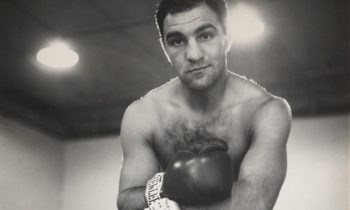 By Michael Swanger
By Michael Swanger
Fifty years after his death, Rocco Francis Marchegiano, best known as Rocky Marciano, is remembered as one of the greatest heavyweight boxers of all time and a 1950s cultural icon who inspired the character, name and relentless fighting style of the title character “Rocky Balboa” in Sylvester Stallone’s series of blockbuster “Rocky” movies.
Among boxing historians and fans, “The Rock,” as Marciano was known, is revered for having held the world heavyweight title from 1952 to 1956 and being the only heavyweight champion to have retired undefeated as champion with a record of 49-0. To this day, his knockout-to-win percentage of 87.76 percent remains one of the best in his class in the history of the sport and he is enshrined in the International Boxing and World Boxing halls of fame.

However, 50 years after his tragic death on Aug. 31, 1969, the eve of his 46th birthday, few recall that Marciano perished in a plane crash near Newton that also claimed the lives of two men from Des Moines: pilot Glenn Belz, 37, and family friend, Frankie Farrell, 22.
Marciano, Belz and Farrell were aboard a 1967 Cessna 172-H when they left Chicago’s Midway Airport on Aug. 31 at 5:58 p.m., “despite warnings of stormy weather on their flight path,” according to Gary Lucken for Boxing Monthly. The trio was headed to Des Moines where Farrell, a former Dowling High School sports star, was opening an insurance business and the former champ was slated to make an appearance. Farrell’s father, Lew, a former boxer in Des Moines, had known Marciano since his childhood. The Rock planned to return to his Florida home on the morning of Sept. 1 to celebrate his birthday that day with his family.
Sadly, he never made it home alive.
“At 8:50 p.m. Belz, with Marciano sitting alongside him at the front of the Cessna, contacted air traffic control at Des Moines Airport to say he was in the area but could not see the city because of the cloudy and drizzly conditions,” Lucken wrote in 2017.
It was nighttime and Newton was experiencing bad weather. The pilot — who had logged in 231 total hours of flying time, with only 35 at night, and had no instrument rating — reportedly asked for a radar position “fix” before confirming that he could see the lights of Newton and that he would land there to refuel.
At 9:05 p.m. the Cessna descended and hit an oak tree in a wooded pasture about two miles southwest of Newton Airport’s runway. The impact tore off a wing and the small plane bounced across farmland for approximately 250 feet before resting in a creek bed. All three men were killed on impact. Marciano was found dead under the fuselage.
Colleen Swarts, who lived near the crash site then told reporters that she heard the plane “sputtering” overhead, adding: “It sort of stopped right over our house and I was scared to death it would fall on us … I could see the lights on the plane. It sort of drifted away and I heard an awful thud. I knew what had happened … I never dreamed anybody like Rocky Marciano was in it.”
After the crash, the National Transportation Safety Board report said, “The pilot attempted an operation exceeding his experience and ability level, continued visual flight rules under adverse weather conditions and experienced spatial disorientation in the last moments of the flight.” No evidence of airplane mechanical problems, or health issues with the pilot were found.
Unlike the plane crash near Clear Lake in 1959 that killed Buddy Holly and three others, the one that claimed the lives of Marciano, Belz and Farrell in 1969 is relatively lost on our state’s collective conscience as no memorial exists to honor their memories 50 years later … except for those in the hearts and minds of fans and loved ones.
TO READ MORE FASCINATING STORIES ABOUT IOWA HISTORY, subscribe to Iowa History Journal. You can also purchase back issues at the store.
